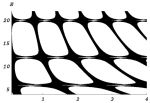EPJ B Highlight - Nano-pea pod model widens applications
- Details
- Published on 31 July 2014

A new theoretical model outlines the conditions under which a novel nanostructure, such as the nano-pea pod, can exhibit localised electrons for electronics applications
Periodic chain-like nanostructures are widely used in nanoelectronics. Typically, chain elements include the likes of quantum rings, quantum dots, or quantum graphs. Such a structure enables electrons to move along the chain, in theory, indefinitely. The trouble is that some applications require localised electrons - these are no longer in a continuous energy spectrum but in a discrete energy spectrum, instead. Now, a new study by Russian scientists identifies ways of disturbing the periodicity of a model nanostructure to obtain the desired discrete spectrum with localised electrons. These findings have been published in EPJ B by Dr. Eremin from the Mordovian State University, in Saransk, Russia and colleagues.
Theoretical calculations on nano-systems play an important role in the prediction of electrical transport properties. The authors created theoretical models of nanometric scale entities dubbed nano-pea pods. The latter are made of a nanotube filled by a chain of fullerene molecules. Such models are based on a bent chain of spheres connected by wires.
They then described the energy spectrum of systems with disturbed periodicity and set out to find the condition for the appearance of localised electrons. To do so, they relied on a method based on the so-called general operator extensions theory. They varied the length of the connecting wires, the intensity of the disturbance and the value of the bending angle.
They found that localised electrons’ appearance has a stronger dependency on the variation of the length of the wires of the bent chain than the variation of the value of the bending angle. It is consistent with the fact that a local perturbation does not affect the continuous spectrum. As the bending angle tends towards zero, the electrons tend to become less localised.
D. A. Eremin, D. A. Ivanov1 I. Yu. Popov (2014), Electron energy spectrum for bent chain of nanospheres, European Physical Journal B, DOI: 10.1140/epjb/e2014-50002-0




